CCNA – Troubleshooting 1
Here you will find answers to Trouble Shooting Questions (Part 1)
Question 1:
Refer to the exhibit. The network administrator is in a campus building distant from Building B. WANRouter is hosting a newly installed WAN link on interface S0/0. The new link is not functioning and the administrator needs to determine if the correct cable has been attached to the S0/0 interface. How can the administrator accurately verify the correct cable type on S0/0 in the most efficient manner?
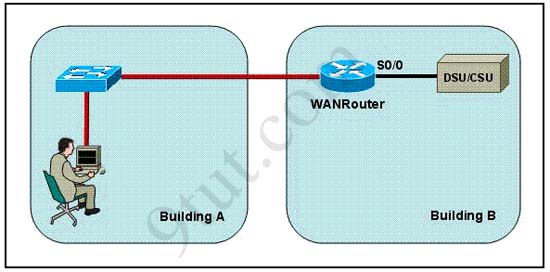
A. Telnet to WANRouter and execute the command show interfaces S0/0
B. Telnet to WANRouter and execute the command show processes S0/0
C. Telnet to WANRouter and execute the command show running-configuration
D. Telnet to WANRouter and execute the command show controller S0/0
E. Physically examine the cable between WANRouter S0/0 and the DCE.
F. Establish a console session on WANRouter and execute the command show interfaces S0/0
Answer: D
Explanation:
The show controller command displays the information about the physical interface itself and the type of serial cable plugged into a serial port. In this case, it should be a DTE cable that plugs into a type of data service unit (DSU).
For your understanding, below is the output of this command:

From the output, we notice that serial 0/0 has a DTE cable and would get its clocking from the DSU.
Question 2:
Two routers named Atlanta and Brevard are connected by their serial interfaces as shown in the exhibit, but there is no data connectivity between them. The Atlanta router is known to have a correct configuration. Given the partial configurations shown in the exhibit, what is the problem on the Brevard router that is causing the lack of connectivity?
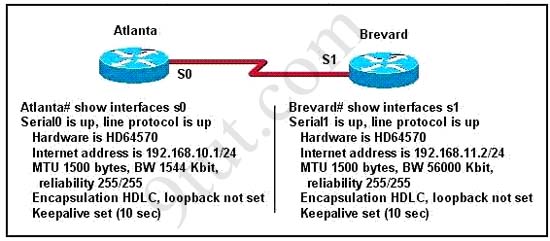
A. A loopback is not set
B. The IP address is incorrect.
C. The subnet mask is incorrect.
D. The serial line encapsulations are incompatible.
E. The maximum transmission unit (MTU) size is too large.
F. The bandwidth setting is incompatible with the connected interface.
Answer: B
Question 3:
Refer to the exhibit. The two exhibited devices are the only Cisco devices on the network. The serial network between the two devices has a mask of 255.255.255.252. Given the output that is shown, what three statements are true of these devices? (Choose three)
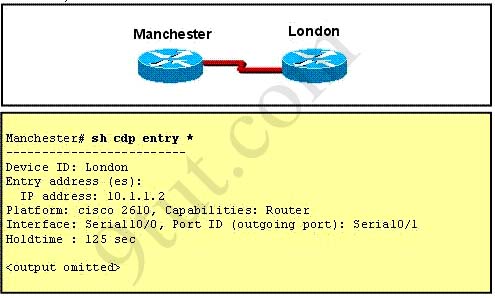
A. The Manchester serial address is 10.1.1.1.
B. The Manchester serial address is 10.1.1.2.
C. The London router is a Cisco 2610.
D. The Manchester router is a Cisco 2610.
E. The CDP information was received on port Serial0/0 of the Manchester router.
F. The CDP information was sent by port Serial0/0 of the London router.
Answer: A C E
Explanation:
From the output, we learn that the IP address of the neighbor router is 10.1.1.2 and the question stated that the subnet mask of the network between two router is 255.255.255.252. Therefore there are only 2 available hosts in this network (22 – 2 = 2). So we can deduce the ip address (of the serial interface) of Manchester router is 10.1.1.1 -> A is correct
The flatform of the neighbor router is cisco 2610, as shown in the output -> C is correct
Maybe the most difficult choice of this question is the answer E or F. Please notice that “Interface” refers to the local port on the local router, in this case it is the port of Manchester router, and “Port ID (outgoing port)” refers to the port on the neighbor router -> E is correct.
Question 4:
A network administrator has configured two switches, named London and Madrid, to use VTP. However, the switches are not sharing VTP messages. Given the command output shown in the graphic, why are these switches not sharing VTP messages?
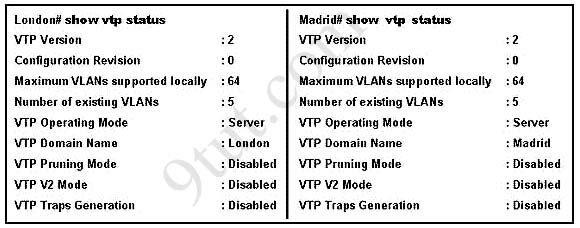
A. The VTP version is not correctly configured.
B. The VTP operating mode is not correctly configured.
C. The VTP domain name is not correctly configured.
D. VTP pruning mode is disabled.
E. VTP V2 mode is disabled.
F. VTP traps generation is disabled.
Answer: C
Explanation
In the exhibit, the Domain Names of 2 switches are mismatched (one is “London” and the other is “Madrid”) so these switches do not share VTP messages -> The VTP domain name is not correctly configured. Notice that the Domain Names should be the same on both switches to share VTP messages.
Question 5:
The network shown in the diagram is experiencing connectivity problems. Which of the following will correct the problems? (Choose two.)
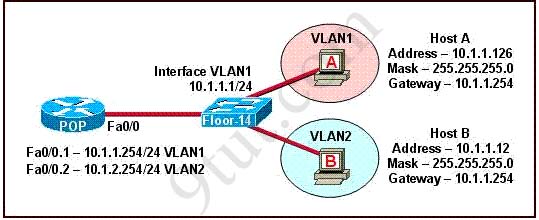
A. Configure the gateway on Host A as 10.1.1.1.
B. Configure the gateway on Host B as 10.1.2.254.
C. Configure the IP address of Host A as 10.1.2.2.
D. Configure the IP address of Host B as 10.1.2.2.
E. Configure the masks on both hosts to be 255.255.255.224.
F. Configure the masks on both hosts to be 255.255.255.240.
Answer: B D
Question 6:
Refer to the exhibit:
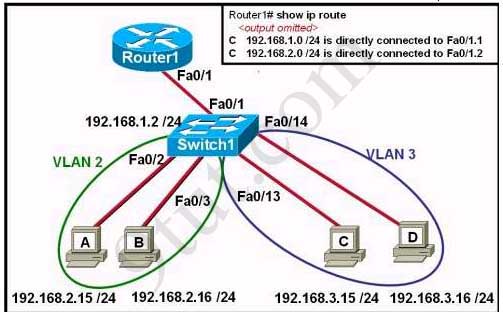
The network administrator has created a new VLAN on Switch1 and added host C and host D. The administrator has properly configured switch interfaces FastEthernet0/13 through FastEthernet0/24 to be members of the new VLAN. However, after the network administrator completed the configuration, host A could communicate with host B, but host A could not communicate with host C or host D. Which commands are required to resolve this problem?
A. Router(config)# interface fastethernet 0/1.3
Router(config-if)# encapsulation dot1q 3
Router(config-if)# ip address 192.168.3.1 255.255.255.0
B. Router(config)# router rip
Router(config-router)# network 192.168.1.0
Router(config-router)# network 192.168.2.0
Router(config-router)# network 192.168.3.0
C. Switch1# vlan database
Switch1(vlan)# vtp v2-mode
Switch1(vlan)# vtp domain cisco
Switch1(vlan)# vtp server
D. Switch1(config)# interface fastethernet 0/1
Switch1(config-if)# switchport mode trunk
Switch1(config-if)# switchport trunk encapsulation isl
Answers: A
Question 7:
Refer to the exhibit. Hosts on the same VLAN can communicate with each other but are unable to communicate with hosts on different VLANs. What is needed to allow communication between VLANs?
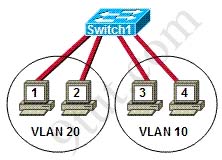
A. a switch with a trunk link that is configured between the switches
B. a router with an IP address on the physical interface that is connected to the switch
C. a switch with an access link that is configured between the switches
D. a router with subinterfaces configured on the physical interface that is connected to the switch
Answer: D
Question 8:
The show interfaces serial 0/0 command resulted in the output shown in the graphic. What are possible causes for this interface status? (Choose three)
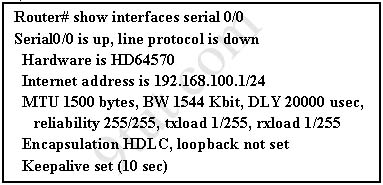
A. The interface is shut down.
B. No keepalive messages are received.
C. The clockrate is not set.
D. No loopback address is set.
E. No cable is attached to the interface.
F. There is a mismatch in the encapsulation type.
Answer: B C F
Question 9:
While troubleshooting a connectivity issue from a PC you obtain the following information:
Local PC IP address: 10.0.0.35/24
Default Gateway: 10.0.0.1
Remote Sever: 10.5.75.250/24
You then conduct the following tests from the local PC:
Ping 127.0.0.1 – Successful
Ping 10.0.0.35 – Successful
Ping 10.0.0.1 – Unsuccessful
Ping 10.5.75.250 – Unsuccessful
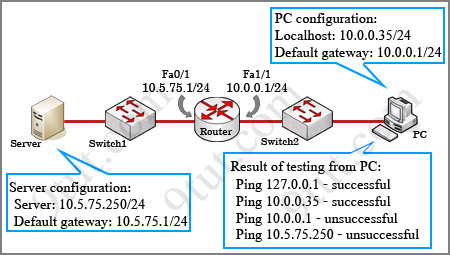
What is the underlying cause of this problem?
A. A remote physical layer problem exists.
B. The host NIC is not functioning.
C. TCP/IP has not been correctly installed on the host.
D. A local physical layer problem exists.
Answer: D



@Jane
any address in the 192.168.10.2 ~ .254 range
@xallax
Q2.
Atlanta: Internet address 192.168.10.1/24
Brevard: Internet address 192.168.11.2/24
Isn’t a consideration that 10.1/24 and 11.2/24 may be two different subnet? Hence belong to seperate networks. Thanks.
@anonymous
yes, true. i was just replying to jane’s question
@xallax
Thank you.
Please, if my arguement is true, then what is causing connectivity issue with Q2?
@anonymous
the two devices are not part of the same network (as you noticed above).
@xallax
Thanks.
I get it. I suppose the answer is buried in the question itself. Thanks again.
Hey hi,
This is Nikhil.
i like all qustion which you have uploded.
I want to read more qustion & their answer so please help me.
I request you to upload more question & their answer.
& I think they will help me to increse my Knowledge about Networking & also trouleshoot as well.
Hello Friends,
Today i cleared my CCNA with very Good marks
i Guess The Information here would be of great to write CCNA
Labs were almost most the same with few changes
I got one access list
vtp, EIGRP
Any Info Required Please do mail me
chandra.kumar24@gmail.com
” Life Is Like A Object ,Floating Without Gravity..
All It Required Is A little Push……”
I think for Question No 9 Correct answer is C . What say Guys . Just want to know your thoughts !!!
@Nawaj
If the problem is with TCP/IP has not been correctly installed on the host you cannot ping loopback address: 127.0.0.1
hi!! help please!!
*Computer 1 is consoles into switch A. Telnet connections and pings run from the command prompt on switch A fail. Which of the following could cause this problem?
Computer 1 –> Switch A –> Switch B –> Router 1
—————————————————-
Sw A#show run
hostname A
interface fastethernet 0/1
switchport mode trunk
no ip address
interface vlan 1
no ip address
no ip route – cache
———————————————————
A. switch A does not have a cdp entry for switch B or router JAX
B. switch A does not have an IP address
C. port 1 on switch A should be an access port rather than a trunk port
D. switch A is not directly connected to router JAX
E. switch A does not have a default gateway assigned
Answer: E
Why the answer is E??.. Explain to me. In the packet tracer, i can ping without default gateway but not without ip address. Then, the answer should be B.. right??
@9tut
The answer to Q4 is too obvious. It does not even require to look at the output. The answer is in the question. The network admin has configured two switches with two different names, to use VTP. Obviously, this two switches will not share their VTP information, which will result to connectivity issues.
I guess all am saying is, the question should be reworded in a way to make it more challenging. It will help us improve our skills, mentally. Cisco is tricky when it comes to question. I don’t expect any less. Thanks.
@Koffy: In fact, the question only want to mention that the two switches are named London and Madrid (hostname). The question doesn’t say they are in two different domains so we still need the exhibit to select the best answer.
hi all
someone give me the correct answer for this question
wich command will show the mac address connecteds to switch ports:
*show mac-address
*show arp
*show table
*show switchport
plz and thanks
@jawad
correct answer: show arp
@9tut
can you please please please add this question to basic or troubleshooting or switching questions question?
thank you
thank you so much xallax
About Q9. Everything from PC to default gateway is considered local and past that remote?
Q9 – correct answer should be “A”. Answer “D” is incorrect as ping to the localhost and local IP address are fine!
@ara I also think the correct answer is B. I wonder why no one replied to your question
@sotir1984-Yes
@yaloo
Q9 – ping to default gateway failed, so it must be local physical problem. Answer is D.
@yaloo
@vanessa
@sortir1984
Option D says LOCAL PHYSICAL LAYER……L1
TCP/IP stack is fine, reason ping to local host is fine…..127.0.0.1
127.0.0.1 is fine………………….L3
So if we can go past default gateway to reach a remote network, what do you think is the cause?……………L1
Correction………….can’t go past………………..
@Koffy, and others :)
My mistake, you are right – I do not know why but I have taken the Decapsulation way instead of Encapsulation.
Regards.
@ara
Go to CCNA – Switch Questions 2. Quote :
“Answer: B
Explanation
It’s a hard question to answer although it looks simple! From the output above we are sure that switch A does not have an IP address (on both Fa0/1 and on VLAN 1) so it can not ping or telnet to any other device -> B is correct.
Another answer seems to be correct is answer E – switch A does not have a default gateway assigned. We know that Switch A can not telnet to other device outside its subnet without having a default gateway. But the question only says “Telnet connections and pings run from the command prompt on switch A fail” without telling us where Switch A is trying to telnet or ping to. If it tries to connect to the outside network then E is correct. If it only want to connect to a device inside its subnet then a default gateway is not necessary.
So the best answer for this question is B! ”
It would have said B also, but I’m still not 100% sure.
please someone explain why select D as answer for Q9??
please help me..i have confuse about dis ans…
@bakki
We cant ping the default gateway, so there is no connection between host and gateway.
The pings to the host and loopback addresses prove that the NIC is working and TCP/IP is configured correctly.
@ Anonymous
I understand what you say
I think that the answer D Q9 should be more elaborate than it was. Example: “Problem in the phisical connection” or “Problem in the physical layer”. A more generic idea as these examples
@fE
Option D – LOCAL PHYSICAL LAYER……..…L1
TCP/IP stack is fine,(ping to local host is fine)……..127.0.0.1
127.0.0.1 is fine………………….L3
So, if we can’t go past default gateway to reach a remote network, what do you think is the cause?……………L1(Physical layer)
when we cant reach the remote device we would get an message host unreachable from the router if we are not getting that messages instead we are getting unsuccessful pings then its a layer 1 problem……
For Q9:if you see on router Port Fa 1/1 is down,we will think about physical problems, like connection cable etc etc.
How to see that on pictures of Q9 ??
Those question sometimes are rubish,just with pictures is nothing ….
For Q9 the right choice is the A?
If you have local physical layer problem you can’t ping 127.0.0.1 , right??
Can someone help me with Q4 ? I understand that Domain name need to be same for sharing VTP messages . Lets assume the domain name is same in both switches, in that case can both be configured in “server ” operating mode ? isthis possible ?
@sathish
yes sir, they can both operate in server mode and will update one another.
actually, that’s what you will most likely see in an operation environment: all switches in vtp server mode.
why? because the admins don’t enjoy telnetting to the single switch that operates in vtp server mode so they let all of the in server mode. that makes their task a bit easier (but also a bit more insecure).
I am going to agree with the concensus on Q9. It is worded in a way to do nothing more than fail you not test your knowledge. I also had it as answer A, had I known they were reffering to LOCAL as being up to the router interface, I obviously would have chose D.
@Sathish: AFAIK by default any Catalyst switch is in a server mode.
Look here: http://www.cisco.com/en/US/tech/tk389/tk689/technologies_tech_note09186a0080094c52.shtml#vtp_v2
Q2 is wrong….
on a point to point network address doesn’t have to match or even the same group. When a ping is sent there is only one way for it to go so it will get there. If you don’t believe me try it yourself. The only problem i see with it is that the bandwidth doesn’t match and that will stop keep-alive.
Q9 is worded wrong as what DimS says, the word localhost use the address 127.0.0.1.
Hello all,
Need assistance in restoring password. I am trying to reset the lost password in Packet tracer. But not able to execute the break option while rebooting.. can you please help me out in this?
@Shasam:
1. “Bandwidth” is not equal “clock rate”. Bandwidth is a value that used e.g. in calculating routes in EIGRP and don’t affect to L2. But mismatch in clock rates will result to problems on L2. (Line protocol is down.)
2. On a point-to-point links addresses have to be in same subnetwork. Usually for conserving address space is using /30 subnet.
Hi 9tut… Hi Guys! Can you please help me… I will take exam this Feb. Please send me latest dump so that I will have an idea for the exam.. rico.blake@ymail.com
Thanks Guys!
@9tut and @xallas
Q2.
the bandwidth shown in both the switches are different.How can they send data or packets when the link is point to point and has different bandwidth??
how can a single link or physical wire have two different bandwidths??
pls help me
@anup
to which question are you referring?
question number 2
another question…anyone pls help
a network setup which has two switches and six hubs.
how many broadcast domain does it have????
in my opinion it is 8…but acme dump says 1….any1 pls pls help…thanks in advance
i got the answer for broadcast domain question….sorry guys….but pls do help me in the previous question i asked
@anup:
1. This is not switches. This is routers.
2. Bandwidth is used as a metric for some routing protocols, and doesn’t define a real physical speed of serial interface. Real speed you can set by command “clock rate “.
E.g.:
conf t
int s0
clock rate 128000
band 25
^Z
@dims…said switches bymistake
n oh ya…clockrates r used for the purpose..ya u r right….thanks a lot dude
@anup: another question…anyone pls help
a network setup which has two switches and six hubs.
how many broadcast domain does it have????
———————-
1 broadcast domain because switches are L2 devices and they break collision domains.
@ dimS…i got the answer of dat question soon after i posted my question…ny ways appreciate ur effort in helping me sir…thank you
Q9
I think everybody agree that it is L1 problem.
But why couldnt be remote L1 problem, example f1/1 is in admin down, down, cable is out… or why couldnt be problem with the switch? kind of port can be in admin down…
??????????